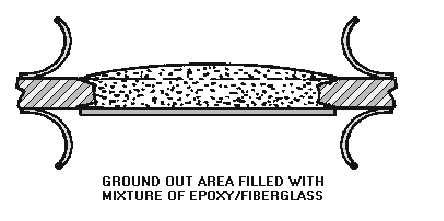3-35
must not flex the board. Rebuilding techniques must be used to repair damage, such as cracks, breaks, and
holes that extend through the board. The following steps are used to repair cracks:
1. Abrasive methods are used to remove all chips and fractured material.
2. The edges of the removed area are beveled and undercut to provide bond strength.
3. A smoothly surfaced, nonporous object is fastened tightly against one side of the removed area.
4. The cutaway area is filled with a compound of epoxy and powdered fiberglass (figure 3-27).
Extreme care is exercised to prevent the formation of voids or air bubbles in the mixture.
Figure 3-27.—Repair of cracked pcbs.
5. The surface of the filled area is smoothed to make it level with the surface of the original board.
6. The board is cured, smoothed, redrilled, and cleaned.
Broken Board Repair
Broken boards should be examined to determine if all parts of the board are present and if circuit
conductors or components are affected by the break. They are also examined to determine if the broken
pieces may be rejoined reliably or if new pieces must be manufactured.
Breaks and holes are repaired in the same manner as cracks unless broken pieces are missing or the
hole exceeds 1/2 inch in diameter. In such cases, the following repair steps are used:
1. The same technique used in repairing cracks is used to prepare the damaged edge.
2. A piece as close in size to the missing area as possible is cut from a scrap board of the same type
and thickness. The edges of this piece are prepared in the same manner as the edges of the hole.
3. A smooth-surfaced object is tightly fastened over one side of the repair area, and the board is
firmly clamped in an immovable position with the uncovered area facing up.
4. The replacement piece is positioned as nearly as possible to the original board configuration and
firmly clamped into place.

